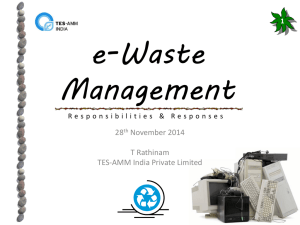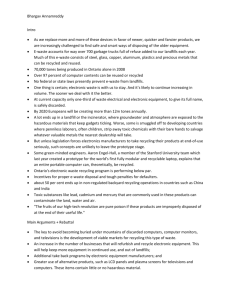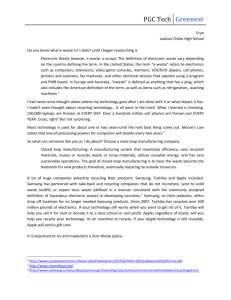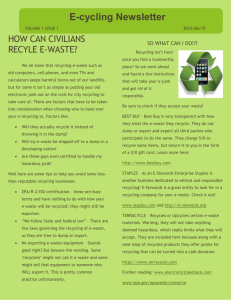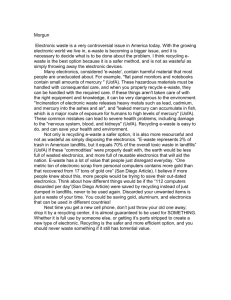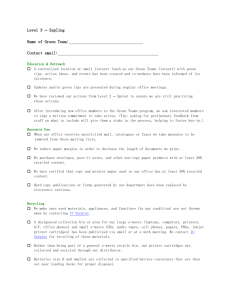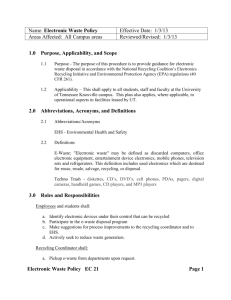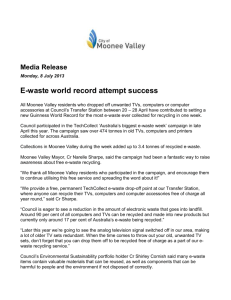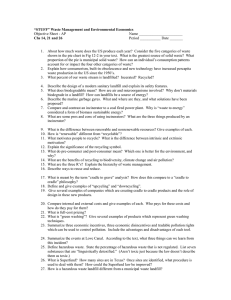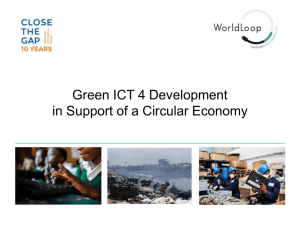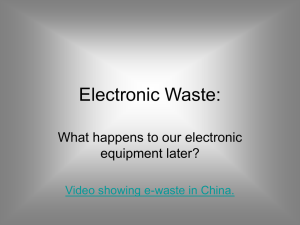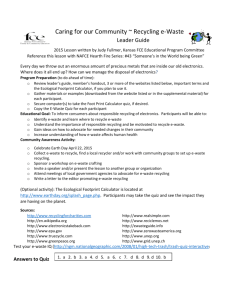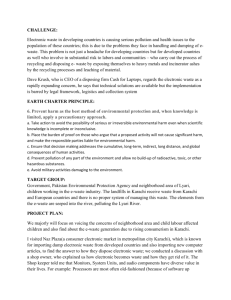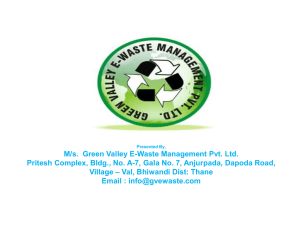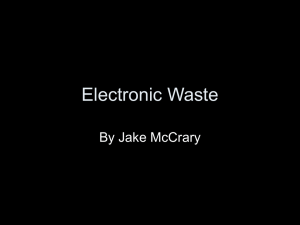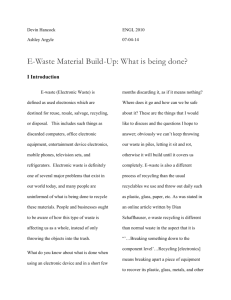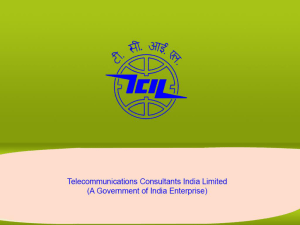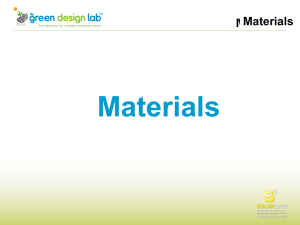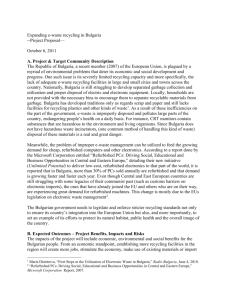Save Earth from E-waste
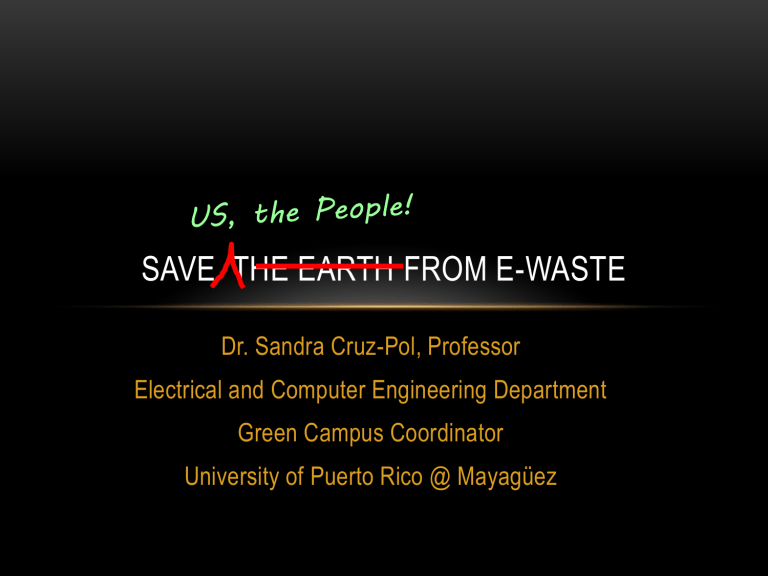
SAVE THE EARTH FROM E-WASTE
Dr. Sandra Cruz-Pol, Professor
Electrical and Computer Engineering Department
Green Campus Coordinator
University of Puerto Rico @ Mayagüez
FB ‘map of the world' created using friendship connections
What we don’t see.
What is e-waste?
• All electronic and electrical appliances and comprise of items such as computers, mobile phones, digital music recorders/players, refrigerators, washing machines, televisions and many other household & office consumer items.
Cellphones density
• Europe, Australia have
DOUBLE
• 2x the density of cellphone that U.S.
• In 1 decade (‘92-’02) consumer electronic sales including PC’s Quadrupled
• x4
Growth of e-waste
• New electronic gadgets and appliances have infiltrated every aspect of our daily lives, providing our society with more comfort, health and security, with easy information acquisition and exchange.
• This new kind of waste is known as Electronic waste, also termed as E waste and its constituents are highly complex and toxic.
Planned Obsolescence & Perceived Obsolescence
Average life of:
• PC is only 3 years!
• Cellphone - 2 yrs
• TV ~13 years
Semiconductor power doubles every 18 month!
Economic Models: Unlimited Growth: unsustainable
Planned Obsolescence : Devices are designed to last less and less
Perceived Obsolescence : Fashion or status statement
Watch 7 min video
The Story of Electronics (Ann Lennox)
What’s inside?
• Inseparable, Durable Plastics
• Recyclable Copper
• Hard to separate Glass , ceramics
• TOXIC Metals : Lithium, Cd, Lead, Coltan, Hg
& PCBs, PBDEs, TBBPA, TCE,
• Some are proven carcinogens
• Some are hormone disruptors
• Some linked to many other diseases
Sickness, diseases, syndromes, unknown new conditions
• Cancer rate has 3x en the last 100 years
• Diabetes
• Obesity
• Hormone disruptors
• Birth Defects
• Infertility
• Lung disease
• Other symptoms: nausea, vomiting, rash, discolored nails, headaches, asthma, …
• Lead: : Colic. Bilateral Wrist-drop. Symmetrical Paralysis and Wasting of Shoulder-girdle Muscles.
Social impacts
• Pollution
• Health
• Poverty
• War conflicts (finance sustaining the civil wars in Africa)
Social Impacts: recycling
• The activities of recycling include physical breaking and segregation of hazardous components, burning of PVC wires to retrieve copper, melting of lead and heating mercury-laden components. Abandon of agriculture for mining. Famine
Social Impacts: Extraction of materials
• The process of extraction of gold and copper is also complex and the components are processed through acid baths and require physical handling .
• Mercury is also used to make an amalgam for extraction of gold from the pins and mercury is evaporated into the environment during this process.
• The plastic, which contains Brominated Flame Retardants (BFRs), is broken down to small granules and then recycled, to be used for making toys and other products thus releasing BFRs and toxic fumes into the environment.
• The residues are released in the sewer or nearby land leading to water and soil contamination.
• Most of the people working in this recycling sector are the urban poor with very low literacy levels and hence very little awareness regarding the hazards of e-waste toxics.
• There is a sizeable number of women and children who are engaged in these activities and they are more vulnerable to the hazards of this waste.
Social Impact: Mining
• Work conditions are deplorable & risky
• Most metals can be recycled indefinitely
• We don’t need mines any more if we Recycle all metals.
Social Impacts
• Illegal Disposal disguised as Donation
• Incineration worsen the problem
• Poor Countries, no e-laws
Can we recycle e-waste 100%?
Can Human Beings come up with creative ideas on how to design electronics that are not harmful to our health , contaminate our lakes, air and soil?
Green Solutions
1.
Stricter laws of disposal/recycling of e-waste
2.
Cradle to Cradle (C2C) vs. Cradle to Grave Design
3.
Take-back programs from e-corporations
Take-back Programs
Offered by:
• Cellphones : AT&T
• TV : Samsung, LG, Sony
• PC: Apple accepts old pc’s free of charge in Japan, Taiwan
• But this is not enough, it does not ensure proper recycling or
C2C.
• Prevention is cheaper that the cost of cleaning up the air/soil/water from e-waste pollution and cost of healthcare.
VIDEO
• Watch Cradle to Cradle movie (3min)
Students from Stanford University and Finland’s Aalto
University designed a recyclable laptop in 9 months!
Disassembled for recycling:
• In 10 easy steps
• With no tools
• Within 30 sec. to 2 min.
http://usa.autodesk.com
• 1.9 to 2.2 million tons of electronics became obsolete in 2005, with only 345,000 to 379,000 tons being recycled. The other 1.5 to 1.8 million tons (80%) ended their lives in landfills.–
EPA
• Students were from mechanical engineering , some from business & industrial design.
References
• High Tech trash : Digital Devices, Hidden Toxics, and Human Health,
E.Grossman, 2006
• Environmental Protection Agency www.epa.gov
http://www.epa.gov/international/toxics/index.htm
• Cradle to Cradle : Remaking the Way We Make Things by William
McDonough and Michael Braungart 2002
• Toxics Link www.toxicslink.org
• World Health Organization www.who.org
• National Institute of Environmental Health Sciences www.ehp03.niehs.nig.gov
• http://www.ielf.tuclausthal.de/fileadmin/user_upload/lager/Dar_es_Salaam2009.pdf
World Population
Who’s involved in making international legislation?
This is NOT sustainable
Save Ourselves from e-waste
